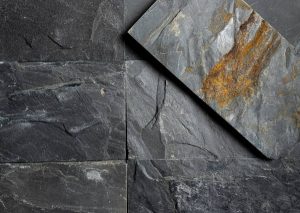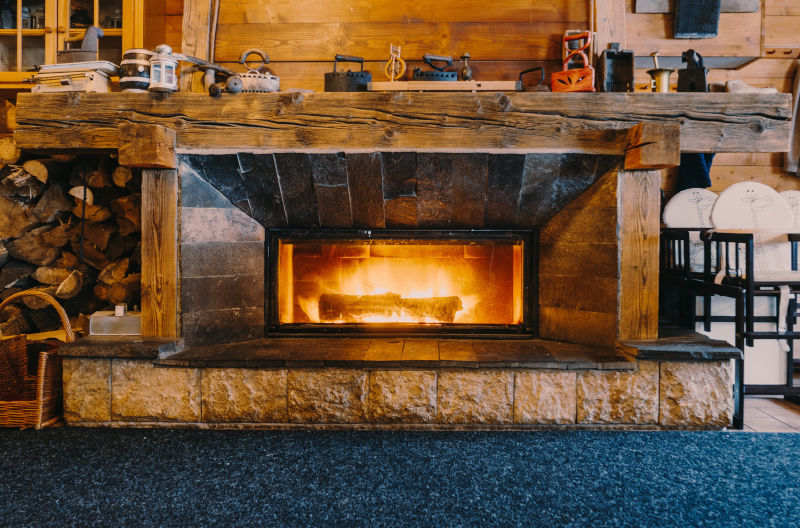Tiling a fireplace is sometimes a bit of a builder’s nightmare—but it definitely doesn’t have to be. The right kind of tile adhesive can make the job a whole lot easier. Can you use normal tile adhesive for a fireplace?
You shouldn’t use ordinary tile adhesive when tiling a fireplace. It will almost certainly not be able to take the heat, and you stand a chance of the tiles cracking or coming loose entirely. Depending on the heat the fireplace will reach, you’re going to need a powdered cement adhesive and grout.
So, the first point to get out of the way is that not all fireplaces are the same. Some will get much hotter than others. In any case, normal tile adhesive will never be enough. Read on to find out more.
What’s the best tile adhesive for a fireplace?
 The best tile adhesive for a fireplace can change depending on the structure and how far the tiles are from the heat source. For fires that do not burn all that hot, there is a variety of heat resistant adhesives. Palace Heat Resistant S1 Adhesive, for instance, is a powder-based mortar that can be used around log burners and fireplaces. This adhesive can withstand temperatures of up to 250 degrees radiating from the source—but, no more than this.
The best tile adhesive for a fireplace can change depending on the structure and how far the tiles are from the heat source. For fires that do not burn all that hot, there is a variety of heat resistant adhesives. Palace Heat Resistant S1 Adhesive, for instance, is a powder-based mortar that can be used around log burners and fireplaces. This adhesive can withstand temperatures of up to 250 degrees radiating from the source—but, no more than this.
For anything hotter than 250 degrees, a cement-based adhesive is going to be needed. Everbuild KOS Fire Cement is a powerful adhesive that can handle temperatures up to 1250 degrees. That would be sufficient for the majority of fireplaces.
Though you may not need something as heat resistant as this, you won’t get the job done reliably with ordinary tile adhesive.
What about a firepit, then?
Will normal tile adhesive handle flames from a firepit?
Regular tile adhesive will not be enough to handle flames from a firepit. Any area around the firepit that is too hot to touch will be too hot to tile with regular adhesive. There will be different levels of heat from different firepits which can impact the choice of tile adhesive for your firepit.
Firepits can reach up to 420 degrees, giving off radiant heat of up to 150 degrees. For heat like this, you probably won’t need a cement mix adhesive. A good, strong heat resistant adhesive should do the trick. Something like the Palace Heat Resistant S1 Adhesive mentioned earlier.
Whatever you decide, you’ll need modified adhesive and grout. You should leave spaces between the tiles to give them room to expand, also. Tiles and adhesive work differently than bricks used for firepits.
Do you need different tile adhesive for inside a fireplace?
You will need different tile adhesives for inside a fireplace. Ordinary tile adhesive is completely out of the question—it will be far too hot for that. You’ll need something at the very least heat resistant, and you’ll almost definitely need more than that. Again, cement-based mixtures, as well as grout, are the most heat resistant and probably your best option.
If it’s only a small fireplace, you might get away with heat resistant adhesive. It’s better to be safe than sorry, though. If you use ordinary adhesive, the tiles will be ruined if they break off.
Using porcelain tiles helps absorb some of the heat, too, which works if you are wanting to just use heat resistant adhesive. This is because tiles are better than bricks for heat insulation. If the tile is any closer than 20cm to the fire, then you’ll almost certainly need porcelain.
In any case, the inside of the fireplace is going to need special consideration.
How long after adding tile adhesive can a fireplace be used?
 So, you’ve gotten your fireplace tiled with heat resistant adhesive. How long do you need to leave it before you can start making use of the fireplace?
So, you’ve gotten your fireplace tiled with heat resistant adhesive. How long do you need to leave it before you can start making use of the fireplace?
A good rule of thumb is to wait at least 24 hours before using the fireplace after adding tile adhesive. Whatever you do, don’t rush into using it again. Check the tiling after 24 hours, and see how it looks. If it seems to be set, then you’re most likely good to go. But this is the minimum amount of time. It is sometimes better to wait an extra day to be sure. Plus, if the weather has been damp or muggy, the adhesive may take longer to set.
By leaving it at least 48 hours to set, you will be sure to have full protection against damaging the adhesive. When you’re planning to tile your fireplace, you should be prepared for it to be out of use for a couple of days. The whole process can take a while because you need to be sure to properly clean where the tiles are meant to go. Say it’s on brick, you’ll want to scrub away all the dust and dirt with tools like a coco fibre masonry brush before adding adhesive.
Is tile adhesive heat resistant?
Ordinary tile adhesive is not heat resistant, as most tile never comes in contact with the kind of heat we are talking about here. It is important to understand the different variables with tile adhesive and fireplace tiles. This includes the size and heat of the fire, as well as the distance between the fire and the tiles.
Most adhesives are designed to withstand temperatures around 150-200 degrees. Fireplaces are much, much hotter than this—some wood-burning fires up to 1500 degrees. It’s recommended to keep the tiles at least 14 cm away from the direct heat source.
In any case, using ordinary tile adhesive is never guaranteed to work. The tiles will expand and crack, and the adhesive will not work properly under this kind of heat strain. Tile adhesive is never meant to come into contact with heat like this, so it just isn’t formulated to resist it at all. This is why other methods such as powdered cement adhesive and grout are recommended when tiling a fireplace.
Often stone fireplaces are recommended for their aesthetic and longevity. Possible this is one of the better advantages of stone houses. During your fireplace renovation, check out Paragon Tools for quality bricklaying and masonry tools. Or take a look at our resources to get more renovation ideas like adding a bathroom to a house!



